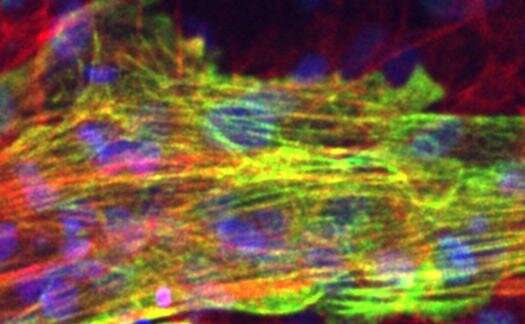Microscopic picture of cardiomyocytes differentiated from human induced pluripotent stem cells. Green indicates cardiac troponin protein, showing typical striated pattern. Red: actin protein. Blue: cellular nucleus. Credit: ©2019 Okayama University
Researchers at Okayama University Graduate School of Medicine, Dentistry and Pharmaceutical Sciences developed a model of myocardial infarction using cardiomyocytes differentiated from human induced pluripotent stem cells.
The journal Biochemical and Biophysical Research Communications published the study, with Ken Takahashi, Ph.D., as corresponding author, and Wei Heng, MSc., a graduate student in the Naruse Lab, as first author.
To date, laboratory animals such as mice have been used to model diseases including myocardial infarction. However, there have been concerns about differences in the characteristics of cardiomyocytes, e.g. heart rate and action of drugs, based on the difference of gene expression between laboratory animals and humans.
Using this model, researchers can evaluate the extent of myocardial tissue damage by microscope morphologically, and by measuring injury-marker proteins and analyzing contractility and its synchroneity from recorded movies quantitatively. Further analysis revealed that gene expression of interleukin-8, an inflammation marker known to increase in acute myocardial infarction, increased in this model.
"This myocardial infarction model will contribute to the development of preventive/therapeutic medicine more effective to humans even without sacrificing animals," said Ken Takahashi, Ph.D., assistant professor in the university and lead author of the study.
More information: Heng Wei et al, Development of a model of ischemic heart disease using cardiomyocytes differentiated from human induced pluripotent stem cells, Biochemical and Biophysical Research Communications (2019). DOI: 10.1016/j.bbrc.2019.09.119
Journal information: Biochemical and Biophysical Research Communications
Provided by Okayama University























